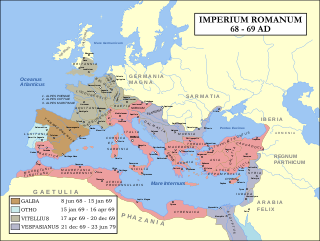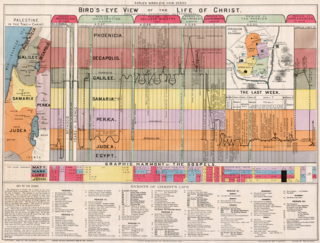
AD 69 (LXIX) was a common year starting on Sunday of the Julian calendar. In the Roman Empire, it was known as the Year of the consulship of Galba and Vinius. The denomination AD 69 for this year has been used since the early medieval period, when the Anno Domini calendar era became the prevalent method in Europe for naming years.

The 10s decade ran from January 1, AD 10, to December 31, AD 19.

The 30s decade ran from January 1, AD 30, to December 31, AD 39.

The 40s decade ran from January 1, AD 40, to December 31, AD 49.

The 60s decade ran from January 1, AD 60, to December 31, AD 69.
6 was a common year starting on Friday of the Julian calendar. In the Roman Empire, it was known as the Year of the Consulship of Lepidus and Lucius Arruntius. The denomination "AD 6" for this year has been used since the early medieval period, when the Anno Domini calendar era became the prevalent method in Europe for naming years.

AD 17 (XVII) was a common year starting on Friday of the Julian calendar. At the time, it was known as the Year of the Consulship of Flaccus and Rufus. The denomination AD 17 for this year has been used since the early medieval period, when the Anno Domini calendar era became the prevalent method in Europe for naming years.
The 0s BC is the period between 9 BC and 1 BC, the last nine years of the before Christ era. It is one of two "0-to-9" decade-like timespans that contain nine years, along with the 0s.

Herod Agrippa, also known as Agrippa I or Agrippa the Great, was the last king of Judea. He was a grandson of Herod the Great and the father of Herod Agrippa II, the last known king from the Herodian dynasty. He was an acquaintance or friend of Roman emperors and played crucial roles in internal Roman politics.

The gens Petronia was a plebeian family at ancient Rome. This gens claimed an ancient lineage, as a Petronius Sabinus is mentioned in the time of Lucius Tarquinius Superbus, the last of the Roman kings, but few Petronii are mentioned in the time of the Republic. They are frequently encountered under the Empire, holding numerous consulships, and eventually obtaining the Empire itself during the brief reign of Petronius Maximus in AD 455.

Gaius Caesar was a grandson and heir to the throne of Roman emperor Augustus, alongside his younger brother Lucius Caesar. Although he was born to Marcus Vipsanius Agrippa and Julia, Augustus' only daughter, Gaius and Lucius were raised by their grandfather as his adopted sons and joint-heirs. He experienced an accelerated political career befitting a member of the Julio-Claudian dynasty, with the Roman Senate allowing him to advance his career without first holding a quaestorship or praetorship, offices that ordinary senators were required to hold as part of the cursus honorum.

Herodias was a princess of the Herodian dynasty of Judaea during the time of the Roman Empire. Christian writings connect her with the execution of John the Baptist.

Herod Antipas was a 1st-century ruler of Galilee and Perea. He bore the title of tetrarch and is referred to as both "Herod the Tetrarch" and "King Herod" in the New Testament. He was a son of Herod the Great and a grandson of Antipater the Idumaean. He is widely known today for accounts in the New Testament of his role in events that led to the executions of John the Baptist and Jesus of Nazareth. His father, Herod the Great, was described in the account as ordering the Massacre of the Innocents, marking the earliest Biblical account of the concerns of the government in Jerusalem regarding Jesus' existence.

A chronology of Jesus aims to establish a timeline for the events of the life of Jesus. Scholars have correlated Jewish and Greco-Roman documents and astronomical calendars with the New Testament accounts to estimate dates for the major events in Jesus's life.

Lucius Vitellius was the youngest of four sons of procurator Publius Vitellius and the only one who did not die through politics. He was consul three times, which was unusual during the Roman empire for someone who was not a member of the Imperial family. The first time was in the year 34 as the colleague of Paullus Fabius Persicus; the second was in 43 as the colleague of the emperor Claudius; the third was in 47 again as the colleague of the emperor Claudius.

Aretas IV Philopatris was the King of the Nabataeans from roughly 9 BC to 40 AD.

Philip the Tetrarch, sometimes called Herod Philip II by modern writers was the son of Herod the Great and his fifth wife, Cleopatra of Jerusalem. As a Tetrarch, he ruled over the northeast part of his father's kingdom between 4 BCE and 34 CE after Herod's death. He was a half-brother of Herod Antipas and Herod Archelaus. He is not the same person as Herod II, whom some writers call Herod Philip I.
The gens Vitellia was a family of ancient Rome, which rose from obscurity in imperial times, and briefly held the Empire itself in AD 69. The first of this gens to obtain the consulship was Aulus Vitellius, uncle of the emperor Vitellius, in AD 32.
Lucius Pomponius Flaccus was a Roman senator, who held a number of imperial appointments during the reign of Tiberius. He was consul in AD 17 with Gaius Caelius Rufus as his colleague.
Chengjia, also called the Cheng dynasty or Great Cheng, was a self-proclaimed empire established by Gongsun Shu in 25 AD after the collapse of the Xin dynasty of Chinese history, rivalling the Eastern Han dynasty founded by Emperor Guangwu later in the same year. Based in the Sichuan Basin with its capital at Chengdu, Chengjia covered a large area including modern Sichuan, Chongqing, Guizhou, Yunnan, and southern Shaanxi, and comprised about 7% of China's population at the time. Chengjia was the most dangerous rival to the Eastern Han and was the last separatist regime in China to be conquered by the latter, in 36 AD.














